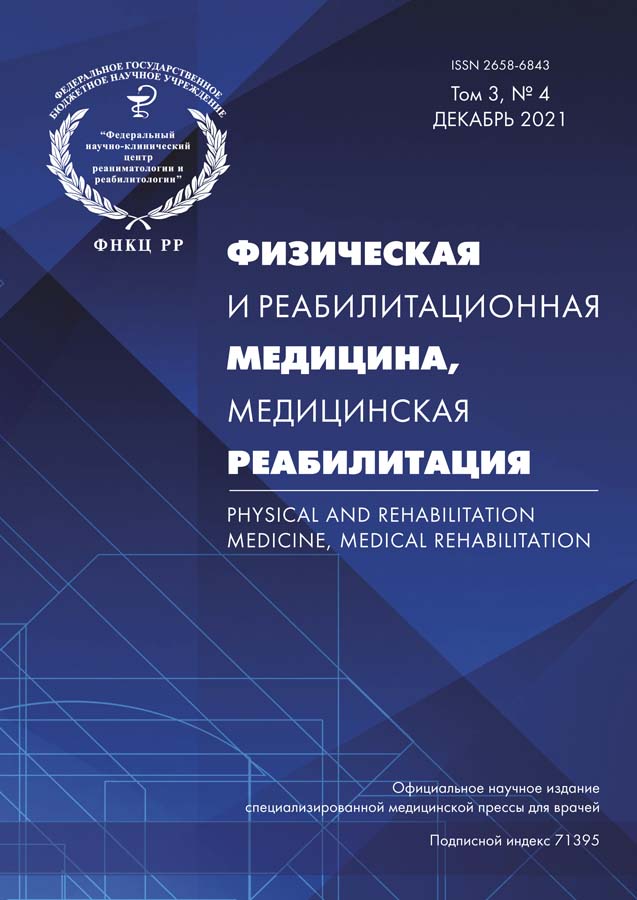Том 3, № 4 (2021)
- Год: 2021
- Выпуск опубликован: 29.11.2021
- Статей: 4
- URL: https://journals.eco-vector.com/2658-6843/issue/view/4177
Весь выпуск
НАУЧНЫЙ ОБЗОР
Циркадианные ритмы и хроническое нарушение сознания
Аннотация
Среди возможных точек терапевтического воздействия и прогнозирования исхода у пациентов в вегетативном состоянии и состоянии малого сознания все большее внимание привлекает анализ циркадианных ритмов, таких как цикл сон–бодрствование, секреция мелатонина, тренды температуры, показатели артериального давления и частоты сердечных сокращений. В обзоре проанализированы результаты исследований суточного ритма у пациентов с хроническим нарушением сознания, выполнена оценка возможных ограничений применения стандартных методов, предложена концепция оценки цикла сон–бодрствование, а также роли вероятных экзогенных факторов, нарушающих циркадианные ритмы в условиях реанимации. По результатам исследования сделан вывод, что полноценная реализация реабилитационного потенциала нуждается в разработке методов оценки циркадианных ритмов на основе многокомпонентного подхода, включающего суточное мониторирование с использованием актиграфии для более точного выявления цикла активности–покоя; видеоминиторинг орофасциальной области для повышения надежности окулографической оценки и выявления скрытых паттернов; анализ температурной кривой, уровня мелатонина, тиреотропного гормона, кортизола, а также экзогенных факторов. Необходимо использование полученных сведений в терапевтических, прогностических, диагностических и реабилитационных целях.
 340-347
340-347


Система HLA и рак
Аннотация
В этом обзоре представлена обновленная информация об антигенах HLA класса I и II при раке. Описана экспрессия HLA-антигенов в нормальных и опухолевых тканях, физиологическая организация компонентов механизма процессинга HLA-антигенов, паттерны экспрессии HLA-антигенов, связанные с выявленными к настоящему времени молекулярными и регуляторными дефектами, а также их функциональное и клиническое значение. Обобщены клинические и экспериментальные данные о сложности механизмов избегания иммунной системы, используемых опухолевыми клетками для предотвращения реакции Т и естественных клеток-киллеров. Представлено разнообразие фенотипов HLA класса I, которые могут продуцироваться опухолевыми клетками во время этого процесса. Обсуждается потенциальная способность метастатических поражений восстанавливать экспрессию HLA класса I после иммунотерапии, которая зависит от обратимого/мягкого или необратимого/ жесткого характера молекулярного механизма, ответственного за измененные фенотипы HLA класса I и определяющего прогрессирование или регресс метастатических поражений в ответ на лечение. Гены HLA класса II играют ключевую роль в соединении врожденного и адаптивного иммунитета и отторжении опухоли, когда путь иммунного уклонения через HLA-I уже установлен. Экспрессия HLA класса II в опухолевых клетках придает им способность представлять антигены, становясь менее агрессивными, и улучшает прогноз. Злокачественная опухоль как генетическое заболевание вызвана структурными изменениями генома, которые приводят к экспрессии ассоциированных с опухолью антигенов в форме структурно измененных или гиперэкспрессированных нормальных молекул. Опухоль-ассоциированный антиген распознается иммунной системой и индуцирует опосредованный Т-лимфоцитами иммунный ответ. Развивающийся рак использует различные стратегии, чтобы избежать разрушения иммунной системой хозяина. Механизмы иммунного уклонения, влияющие на экспрессию и/или функцию антигенов HLA, представляют особый интерес для онкоиммунологов, поскольку эти молекулы играют решающую роль во взаимодействии злокачественных клеток с иммунными клетками. Описаны потенциальная роль контрольных точек иммунитета в иммуносупрессии и терапевтические стратегии восстановления цитотоксичности иммунных клеток.
 348-392
348-392


Новые методы и технологии, дискуссии
Методические аспекты развертывания центра медицинской реабилитации на базе военной санаторно-курортной организации
Аннотация
Одним из направлений использования военных санаториев в мирное и военное время является организация на их базе центров медицинской реабилитации. Медицинский состав лечебно-профилактических учреждений на этапе реабилитации должен иметь четкие представления о месте и значении медицинских мероприятий в общей задаче защите войск, эффективно взаимодействовать с другими специалистами при решении задач обеспечения военнослужащих, проведения реабилитации пораженных и больных с целью скорейшего возвращения реконвалесцентов в строй, медицинской реабилитации пациентов после плановых операций, обеспечения режима обсервации и эффективной постковидной реабилитации больных.
 393-398
393-398


Дистанционная реабилитация: роль и возможности
Аннотация
Медицинская реабилитация — сложный, продолжительный и финансово затратный процесс восстановления физиологических функций организма после травм и последствий перенесенных заболеваний. Индивидуальный подход к каждой жизненной ситуации обусловливает необходимость поиска и разработки новых технологий в методике оказания реабилитационной помощи. Один из принципов успешного реабилитационного процесса — непрерывность, который в большинстве случаев нарушается после перевода пациентов на амбулаторный этап. В отличие от предыдущего, XXI век отличается более доступными технологиями для использования в повседневном и индивидуальном порядке. Отдельной категорией пациентов являются больные с последствиями поражения головного мозга, для которых наиболее сложными задачами в реабилитационной практике являются социализация и возвращение способности к самообслуживанию. Технология дистанционной реабилитации, реализованная в виде Портала дистанционной нейрореабилитации ФНКЦ РР, обеспечивает принцип непрерывности, социальной и информационной поддержки родственников, ухаживающих за больными в амбулаторных условиях.
 399-408
399-408












